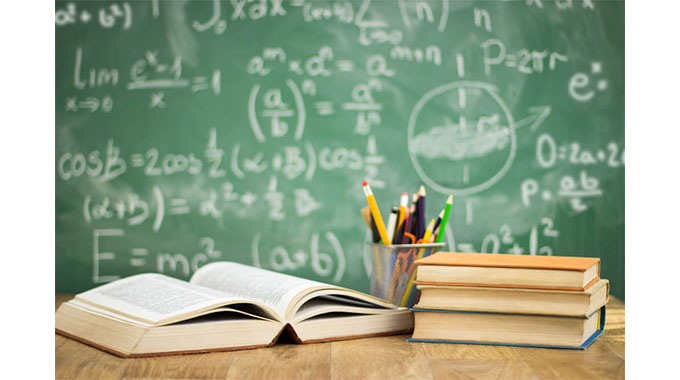Mathematics: A passing formula for all

Jobert Ngwenya
IF I am to reflect on my secondary school learning days, moments that come out alive relate to the teaching and learning of Mathematics. As a way of clarity, I should state that I only passed a Mathematics examination twice during my four-year learning period but I still have interesting memories. Mathematics education plays a crucial role in equipping learners with essential skills for their future endeavours and in retrospect. I have seen this in my, “not so STEM” career. However, it is no secret that many learners find Mathematics intimidating and challenging. In this article, I explore ways to enhance the learning and teaching of Mathematics in secondary schools, with a focus on inclusivity for less gifted learners, Applied Mathematics, Financial Literacy, and other critical interventions in Mathematics.
Despite struggling with Mathematics throughout secondary school, I managed to pass the subject albeit, only twice, in the Form One end of year examination and the final Zimsec General Certificate of Education, Ordinary Level examination. My consistent below par failure was only interrupted by a 46 percent score in the last mock exam before the final exam and of course the best of all, I was able to succeed in the final Mathematics exam. Firstly, without blowing my own vuvuzela, being a good student in all subjects and maintaining a track record of passing exams motivated me to overcome the Maths challenge. Additionally, a belief in the notion that Mathematics was crucial for success in life pushed me to persevere. Furthermore, a “fortunate” delay in the examination schedule (our exam paper leaked) provided me with two weeks dedicated solely to studying Mathematics, during which I extensively read, literally, New General Mathematics Books 3 and 4. Though my experience is unique to me, it serves as a testament to the possibility of passing Mathematics with determination and focused preparation.

Zimsec
In my case, I would say being afraid of both the teacher and the subject really gave me a hard time only to be motivated towards the end having appreciated how important it was for me to pass the subject.
There are different reasons why mathematics is such a headache to an “average” human being and I will not delve into that. I will, however, share a few insights that could be useful, especially considering the ongoing curriculum review. I did a short survey with current and former Mathematics teachers and also checked what other countries are doing. From a bystander’s perspective, and through a rear view insight, motivation or rather lack of it, should be one key factor that makes Mathematics learning a hard time for learners. As Mathematical principles become more abstract with educational levels, motivation takes a dive hence the need for a curriculum that will keep the learner motivated.
Firstly, it is crucial to address the issue of inclusivity and support for less gifted learners in Mathematics education. Traditional approaches that prioritise rote memorisation and abstract concepts often leave struggling learners behind, leading to disengagement and a lack of confidence. To tackle this challenge, it is important to adopt teaching methods that cater to diverse learning needs. One approach is differentiated instruction, which involves tailoring teaching strategies and materials to meet the individual needs of learners. This could include providing additional support through small-group instruction, peer tutoring, or technology-based learning tools. Recognising and accommodating the diverse abilities and learning styles of learners, Mathematics education can become more inclusive and supportive for all learners. Teacher autonomy in both instruction and continuous assessment becomes very important if this is to be successful.
Another key aspect of improving Mathematics education is the integration of Applied Mathematics into the curriculum. Mathematics becomes more meaningful and relevant when learners can see its real-world applications. Applied Mathematics involves using mathematical concepts and techniques to solve problems in practical contexts. By incorporating real-life examples and scenarios into Mathematics lessons, learners can develop a deeper understanding of how Mathematics is used in various fields such as engineering, economics, and technology. Applied learning of Mathematics is possible through a strong formative assessment regime, multi-disciplinary, project based learning. Learners are encouraged to apply mathematical concepts to solve real-world problems, fostering a deeper understanding of mathematical principles.
Additionally, the curriculum should prioritise individualised learning and support for struggling learners. Learners should be allowed to progress at their own pace and receive tailored support when needed. This approach ensures that no student is left behind and that each student’s unique learning needs are addressed. Strategies to provide additional support and interventions for learners who find Mathematics challenging can be explored and assessment should be individualised to meet personal needs. This could involve extra classes, one-on-one tutoring, or online resources that provide personalised learning experiences. For this to happen, a lot of resources will have to be poured into Mathematics education.
As our curriculum appreciates differences in learner cognitive giftedness, it is important to provide a basic Mathematics curriculum up to Form Two and then allow learners to make a choice between “basic” Mathematics and “advanced” Mathematics. For the purposes of this article, basic Mathematics would include arithmetic, geometry, basic statistics and financial mathematics. Allowing learners to focus on these basic branches of Mathematics instead of advanced ones is crucial for several reasons.
Firstly, these foundational branches provide essential skills applicable in everyday life, such as basic numerical operations, measurement conversions, and understanding shapes and spatial relationships.
These practical skills are vital for financial literacy, problem-solving, and decision-making as adults.
Additionally, these branches foster critical thinking, logical reasoning, and pattern recognition abilities, which are transferable to various fields. They also introduce learners to data analysis, statistical concepts, and financial mathematics, equipping them with the necessary tools to make informed decisions, interpret information, and manage their personal finances effectively.
With the emphasis on these fundamental branches, learners develop a solid mathematical foundation and acquire valuable skills that promote their overall development and success in diverse areas of life.
Integrating financial literacy into the Mathematics curriculum equips learners with essential skills for personal financial management, budgeting, and making informed decisions in a world driven by financial transactions. Teaching concepts like interest rates, loans, investments, and basic accounting principles not only enhances learners’ mathematical skills but also prepares them for financial independence and responsible decision-making. For learners choosing “Advanced Mathematics”, there could be an addition of trigonometry, calculus, number theory, advanced geometry, statistics and algebra, branches that relate to physics, mathematical research, cryptography, computer science, engineering and architecture.
There are different strategies that can be used to enhance Mathematics instruction in secondary schools.
Underscoring the real-world applications of Mathematics helps learners understand its relevance in their daily lives. This can be done by incorporating practical examples from various fields such as engineering, finance, and technology. Teachers can demonstrate how mathematical concepts are applied in real-life situations, fostering a deeper appreciation for the subject. Encouraging inquiry-based learning and providing opportunities for learners to actively engage in collaborative problem-solving, teachers can nurture critical thinking, logical reasoning, and creativity. These skills empower learners to approach mathematical challenges with confidence and develop the problem-solving abilities necessary for success in their academic and professional lives.
Furthermore, providing continuous professional development programs for teachers is an important strategy that should be adopted. These programs should focus on equipping teachers with the necessary knowledge, skills, and innovative teaching methods to effectively teach Mathematics. Training sessions can cover topics such as technology integration, strategies for supporting diverse learners, and pedagogical approaches that promote engagement and understanding. Community engagement in Mathematics education that involves collaboration with parents, guardians, and the wider community can create a supportive learning environment for students. When parents are actively involved, students receive consistent support and reinforcement both inside and outside the classroom. This partnership between schools and the community promotes a holistic approach to Mathematics education and helps students develop a positive attitude towards the subject.
In addition to these strategies, the integration of technology can greatly enhance Mathematics instruction. Digital tools, educational apps, and online resources can be utilised to provide interactive and personalised learning experiences. Platforms offering interactive simulations, virtual manipulatives, and adaptive learning can engage learners and cater to their individual needs and learning styles. Technology integration, as much as it can be a long term view in our national context, can give learners the ability to explore mathematical concepts in a dynamic and interactive way, leading to deeper understanding and engagement.
While it is true that Mathematics is a prerequisite for many higher education programs, its value goes beyond that. Mathematics teaches learners problem-solving skills, logical reasoning, and analytical thinking, which are essential in various careers and everyday life. Emphasising the practical applications and relevance of Mathematics in different fields can help learners appreciate and be motivated to learn the subject beyond its examination requirements. In conclusion, improving Mathematics education in secondary schools requires a multifaceted approach. Inclusivity and support for less gifted learners, the integration of Applied Mathematics and financial literacy, and considering providing Basic Mathematics side by side with Advanced Mathematics for Ordinary Level learners.
■ Jobert Ngwenya is an award-winning educator, Fulbright TEA Fellow, National Geographic Education Grantee, author, and academic audio content creator. He holds a Master of Arts in Development Studies (MSU) Bachelor of Arts (UZ) and Post Graduate Diploma in Education (ZOU). He can be contacted by email on [email protected]












Comments